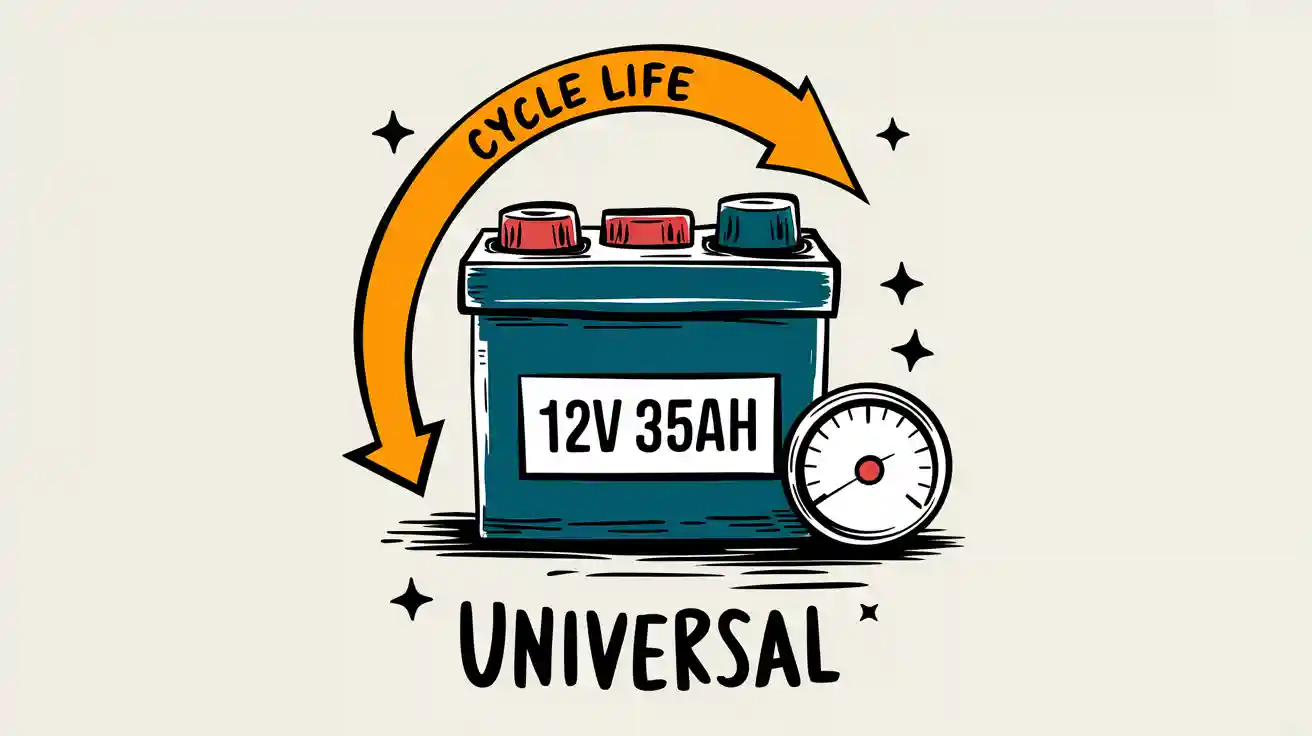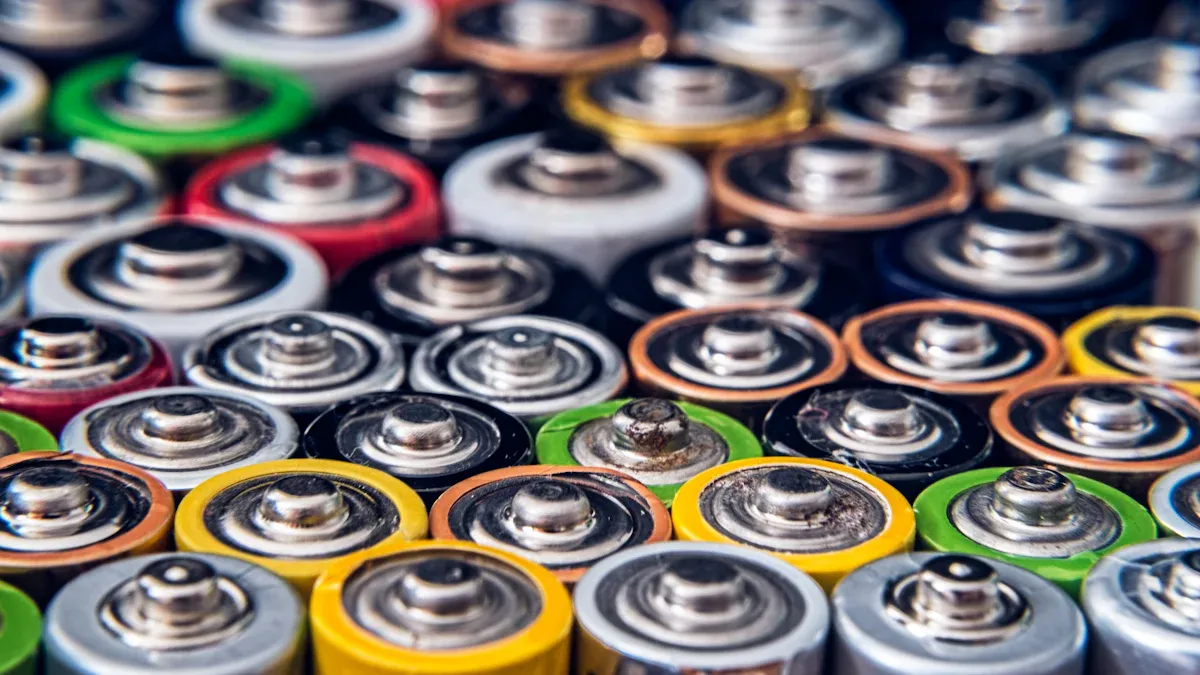
You rely on the cycle life and power output of a 12v 35ah universal battery to ensure consistent performance in demanding environments. The amp-hour rating helps you predict battery life and manage power output for critical 12 volt applications. Review the table below for key features that impact battery selection in professional settings:
Feature | Description |
|---|---|
Voltage and Capacity | 12V, 35Ah capacity indicating the battery’s ability to deliver current over time |
Chemistry | AGM, factory sealed and leak-proof, enhancing reliability and safety |
Durability | Heavy-duty ABS shell, shatter-proof for professional use |
Self-Discharge Rate | Slow self-discharge, retains charge during non-use |
Application | Used in mobility scooters and professional equipment requiring dependable power |
Warranty | 1-year replacement warranty supporting reliability needs |
Cycle life, battery chemistry, and charging practices directly affect battery life and power output in industrial operations.
Key Takeaways
Choose the right battery chemistry—lithium batteries offer longer cycle life and better power output than lead acid, reducing replacement costs and improving reliability.
Follow proper charging practices and avoid deep discharges to extend battery life and maintain steady power, especially in demanding industrial and professional applications.
Manage temperature and use quality charging systems to protect your battery investment and ensure consistent performance in critical environments.
Part 1: 12v 35ah Universal Battery Basics

1.1 Cycle Life Overview
You need to evaluate cycle life when selecting a 12v 35ah universal battery for industrial or professional use. Cycle life measures how many charge and discharge cycles a battery can complete before its capacity drops below 80% of its original value. Lithium battery chemistries, such as LiFePO4, deliver between 2000 and 8500 cycles, far exceeding the 500 to 1000 cycles typical of lead acid AGM batteries. This extended cycle life means lithium battery packs offer longer battery life and lower replacement costs for your operations. The table below compares cycle life across common chemistries:
Battery Chemistry | Typical Cycle Life Range | Depth of Discharge (DoD) | Notes |
|---|---|---|---|
Lead Acid AGM | ~1000+ cycles | 50% DoD | 6 years service life |
Lead Acid Gel | Longer than AGM | Deep cycle use | Sensitive to charging voltage |
Lithium LiFePO4 | 2000–8500 cycles | 30–50% DoD | 10+ years service life |
Tip: For robotics, security, and infrastructure applications, lithium battery packs provide superior cycle life and reliability. Robotics, Security, Infrastructure
1.2 35 Amp Hour Rating
The 35 amp hour rating of a 12v 35ah universal battery indicates its capacity to deliver 35 amps for one hour, or 3.5 amps for ten hours, before reaching its cutoff voltage. You determine this rating by fully charging the battery, applying a constant load, and measuring the discharge time. Battery capacity varies with discharge rate, temperature, and chemistry. Higher discharge currents reduce effective amp-hour capacity, and deep discharging below recommended levels can damage the battery and shorten battery life. The amp-hour rating helps you estimate battery performance and compare different battery types for your application.
To test amp-hour rating:
Fully charge the battery.
Apply a constant load.
Monitor voltage until cutoff.
Calculate amp-hours (current × time).
Use rating to estimate run time and monitor battery degradation.
Note: Amp-hour ratings do not always predict real-world battery life. Factors like temperature, discharge rate, and installation constraints affect actual performance.
1.3 12 Volt Battery Applications
You find 12 volt 35 amp hour batteries in a wide range of B2B applications. These include gate operators, access control systems, emergency power modules, and battery backup systems for security and infrastructure. Medical devices, robotics platforms, and industrial equipment also rely on deep cycle battery packs for dependable power. Leading brands such as LiftMaster and DoorKing use these batteries for commercial installations. Maintenance-free operation, wide temperature performance, and durable construction make the 12v 35ah universal battery ideal for demanding environments.
Common applications:
For best battery life and power output, follow proper battery charging practices and avoid deep discharges.
Part 2: Battery Life, Technology Comparison, and Longevity

2.1 Battery Life Calculation
You need to estimate battery life accurately to ensure reliable power delivery in professional applications. Battery life for a 12V 35Ah battery depends on current draw and depth of discharge. Use the formula:
Battery Life (hours) = Battery Capacity (Ah) ÷ Load Current (A)
For example, if your device draws 0.6A, the battery will last about 58.3 hours (35Ah ÷ 0.6A). If you increase the current draw, the runtime decreases. Drawing more current than the rated amount reduces effective capacity due to the Peukert effect, especially in lead acid batteries. Discharging below 5% of the initial charge can drastically reduce battery life.
Depth of discharge (DoD) plays a critical role. Lead acid batteries perform best when you limit DoD to 50%. Cycling to 80% DoD shortens battery life, while shallow discharges (around 10%) can extend it. Lithium batteries tolerate deeper discharges (up to 90%) with less impact on longevity. You should avoid frequent full discharges, even with lithium battery packs, to maximize cycle life.
You can also estimate runtime using load power and efficiency:
Runtime (hours) = (Capacity (Ah) × Voltage (V) × Efficiency) / Load Power (W)
For a 12V 35Ah battery with 90% efficiency powering a 50W load, runtime is (35 × 12 × 0.9) / 50 ≈ 7.56 hours. Adjust capacity and load values to match your application.
Tip: Always consider both current draw and depth of discharge when planning battery usage for medical, robotics, security, and industrial systems.
2.2 Lead Acid vs Lithium
You must compare lead acid and lithium battery technologies to select the best solution for your B2B needs. The table below summarizes key differences:
Battery Type | Cycle Life (Typical) | Usable Capacity Characteristics | Discharge Characteristics | Maintenance Requirements | Initial Cost per Wh | Cost per Usable kWh over Lifetime |
|---|---|---|---|---|---|---|
Lead Acid | 200–1500 cycles | Lower efficiency (~80%), sensitive to temperature and charge levels, capacity drops faster with deep discharge | Significant voltage sag, recommended 50% DoD, capacity drops quickly at high rates | Maintenance-free (SLA), regular checks for flooded types | $0.15/Wh | $0.55/kWh |
Lithium (LiFePO4, Li-ion) | 1500–5000 cycles (LiFePO4 up to 8500) | Higher efficiency (~90–99%), maintains constant voltage, higher usable capacity, tolerates deep discharge (up to 90–100%) | Stable voltage, minimal sag, deep discharge capability | Minimal maintenance, no memory effect | $0.54/Wh |
Lithium battery packs deliver 5–10 times the cycle life of lead acid batteries.
Lithium batteries maintain consistent power output and voltage during discharge.
Lead acid battery performance drops as voltage sags under load.
Lithium batteries charge faster and perform better at high temperatures.
Lithium battery packs require fewer replacements and less maintenance, reducing total cost of ownership.
Note: For robotics, medical, and infrastructure applications, lithium battery packs offer superior battery performance, longevity, and cost efficiency. Learn more about lithium battery types and battery management systems (BMS) for optimal results.
2.3 Factors Affecting Battery Life
You must manage several factors to maximize battery life and performance in industrial environments:
High temperatures above 100°F accelerate internal discharge and halve battery life for every 15°F above 77°F.
Cold weather reduces energy output and can cause freezing damage, especially if the battery is deeply discharged.
Sulfation results from undercharging, long periods between charges, or low electrolyte levels, reducing capacity and causing failure.
Parasitic drain from connected loads can discharge batteries quickly, requiring regular testing and management.
Incorrect charging levels and poor-quality chargers harm battery life and performance.
Depth of discharge (DoD) is critical: cycling to 50% DoD daily doubles battery life compared to 80% DoD; cycling to 10% DoD can increase life fivefold compared to 50% DoD.
Proper installation in temperature-controlled environments, such as ventilated sheds or battery boxes, is recommended.
Maintaining state of charge above 20–30% and avoiding deep discharges extends battery longevity.
Using a battery management system (BMS) optimizes charging and discharging, further extending battery lifespan.
Tip: Lead acid batteries suffer from sulfation and grid corrosion, while lithium battery packs tolerate deeper discharges and higher cycling frequencies. Always monitor temperature and charging system settings to protect your investment.
2.4 Charging Methods with Solar Panels
You can use solar panels to charge 12V 35Ah universal batteries in remote or off-grid installations. Follow these best practices to maximize battery life and performance:
Avoid deep discharges beyond 20–50% to extend battery life.
Match panel wattage to battery and location: typically 100–200W with MPPT controllers, 150–300W with PWM controllers.
In less sunny regions, use larger panels (140–200W) and higher-capacity batteries (60Ah or more) to maintain battery health and meet load demands.
Ideal charge current for a 35Ah battery is around C/4 (8–9A).
MPPT charge controllers are preferred for efficiency and allow smaller panel wattage compared to PWM.
Discharging a lead acid battery to only 20% state of charge daily can extend battery life to 3–5 years.
For longer daily loads, consider larger capacity batteries to avoid excessive cycling.
Solar charge controllers regulate voltage and current during bulk, absorption, and float phases, preventing overcharging and incomplete charging cycles.
Always connect the battery to the charge controller before connecting the solar panel to establish a stable reference voltage.
Use appropriate gauge wiring (10 or 12 AWG) and verify correct polarity to prevent damage.
Configure charging parameters according to the battery manufacturer’s specifications.
Safety Alert: Select a solar charger compatible with your battery voltage and type. Set the charge controller’s amperage rating 20–30% higher than the solar panel’s current for a safety margin. Proper battery charging practices with solar panels and controllers protect battery life and ensure reliable power output.
You need to evaluate cycle life, power output, and battery longevity when selecting a 12V 35Ah universal battery for professional use. The table below highlights key differences in battery technology:
Battery Type | Cycle Life | Power Output | Service Life | Maintenance |
|---|---|---|---|---|
Lead-acid | ~1000 | Moderate | 6 years | Low |
Lithium | 2000–8500 | Steady | 15–18 years | Minimal |
To maximize battery performance, follow these steps:
Choose the battery chemistry that fits your application.
Use proper charging methods and monitor temperature.
Maintain balanced battery setups and perform regular inspections.
Recharge batteries promptly after discharge.
Store batteries at optimal temperatures.
For custom battery solutions tailored to medical, robotics, security, infrastructure, and industrial needs, visit our consultation page.
FAQ
What is the best way to maximize the cycle life of a 12V 35Ah lithium battery pack?
You should use a high-quality BMS, avoid deep discharges, and follow manufacturer charging guidelines. Large Power recommends regular inspections for all battery installations. Consult our experts for custom battery solutions.
How do lithium battery packs compare to lead-acid batteries in industrial applications?
Feature | Lithium (LiFePO4) | Lead-Acid |
|---|---|---|
Cycle Life | 2000–8500 | 500–1000 |
Usable Capacity | 90% | 50% |
Maintenance | Minimal | Low |
Lithium battery packs deliver higher efficiency and longer service life.
Can I use a lithium battery pack for robotics, security, or infrastructure projects?
Yes. Lithium battery packs offer stable voltage, high energy density, and long cycle life. They suit robotics, security, and infrastructure sectors. Request a custom battery solution.




